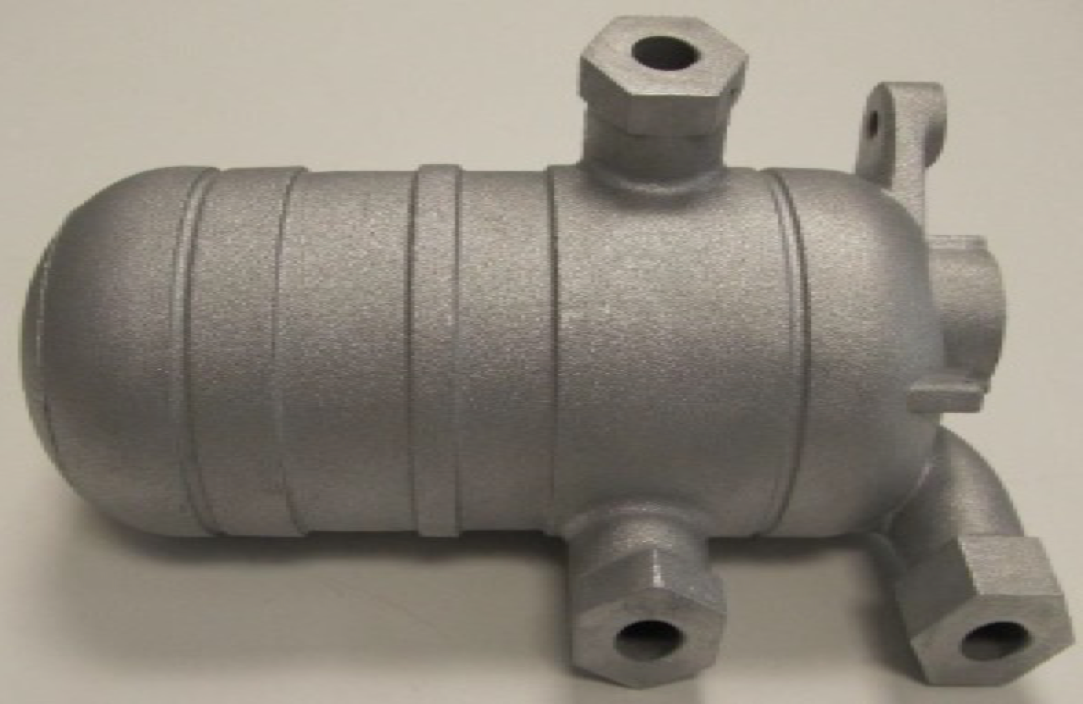


An example of a generic fuel-cooled oil cooler that features thin wall channels (interior not shown) within a shell volume of fuel. Fuel is an active cooling medium for the oil and preheated fuel improves engine efficiency.
Problem
Additive manufacturing (AM) of hard-to-source components is increasingly under consideration for aircraft sustainment. While AM technology offers the potential to substantially reduce lead times compared to wrought or cast parts, there is a lack of critical product performance data necessary for understanding airworthiness. The AM process can create complex internal passages in fewer steps than conventional machining, but access to these internal geometries for inspection is limited, compounding the difficulty involved with the inspection of fuel-cooled oil coolers and heat exchangers. These AM parts require greater scrutiny via proof testing and geometry inspection of the final part. If unresolved, the current lack of confidence in the process could cause unique qualification problems for future AM components.
Objective
The objective of the project was to technically substantiate a qualification pathway by generating data through coupon, sub-element, and full component testing, modeling, and data correlation. The data gathered on the program would be used to aid in future heat exchanger (HeX) development, inspection, and qualification. In addition, the program aimed to compare the fuel-cooled oil cooler (FCOC) printing capability of an experienced OEM partner against that of a smaller, more typical supply chain partner to provide a snapshot in the current HeX AM capability.
Technical Approach
The intent of this effort was to develop enabling technologies for AM component qualification and to highlight areas that represent a qualification barrier and need additional technical development. The research team investigated laser powder bed fusion (LPBF) technologies for end-to-end AM production of an oil cooler. This oil cooler component is representative of a family of parts that are lightly loaded, complex, and important to gas turbine engine efficiency. The initial focus was to define the required elements needed to assemble the technical data package (TDP). The team performed modeling of residual stresses, optimization of the build for orientation and supports, and examination of possible in-situ monitoring techniques which could aid in qualification. A significant portion of the program involved nondestructive evaluation (NDE) and destructive and functional testing. Initially, X-ray computed tomography (CT), laser scanning, ultrasound, and thermography were included in the scope. As the program progressed, X-ray CT and laser scanning became the focus of the project.
Accomplishments
Standard practices and methodologies were developed for the design, manufacture, inspection, and testing of
DoD sustainment fuel-cooled oil coolers printed utilizing F357 aluminum and the laser powder bed fusion additive
manufacturing process. Process modeling challenges were identified and overcome through the creation of design simulation methodologies and the development of processing and printing parameters for the manufacture of Al F357 parts that reduce the number of typical build iterations required to create a successful part. NDE methods were evaluated to determine their usefulness in metrology and for defect detection on complex printed oil coolers. Ultrasound was found to have limited application but had shown potential to measure
wall thickness and possibly measure attenuation which could potentially be correlated to porosity content and print quality. X-ray DR and CT have much broader application and were demonstrated to be useful for metrology purposes, as well as for defect detection. X-ray CT can be used to measure wall thickness and geometric placement for both outer and internal structures as well as defects such as tube blockages, print shifts, crack-like print anomalies, holes, and other defects (such as depressions and possibly corrosion pits).
Project Participants
Project Principal

Other Project Participants
- ANSYS (acquired 3DSIM, LLC.)
- GE Aviation
- DRT Manufacturing CoDRT Manufacturing Co
- Youngstown Business Incubator
- Youngstown State University
Public Participants
- U.S. Department of Defense
